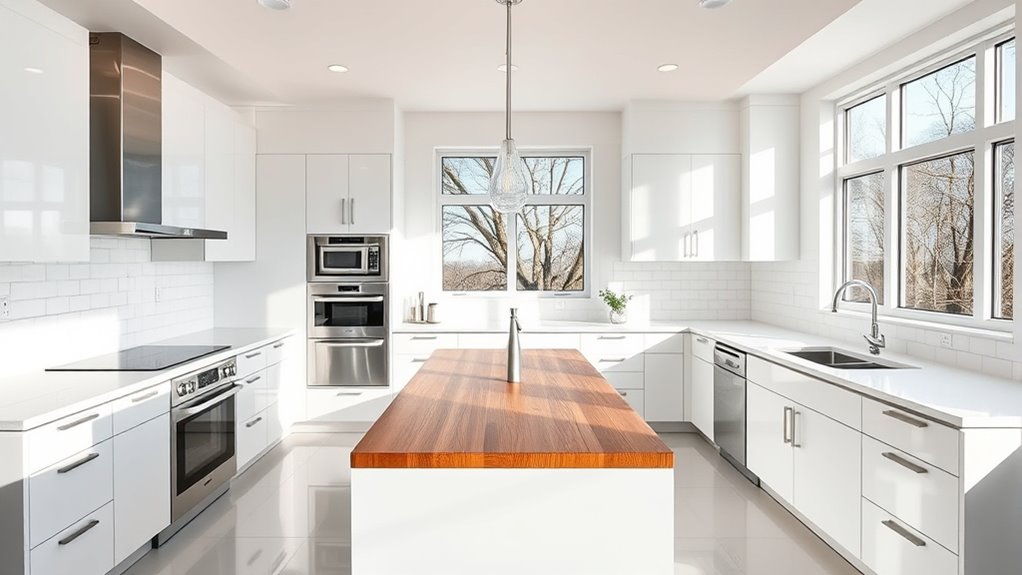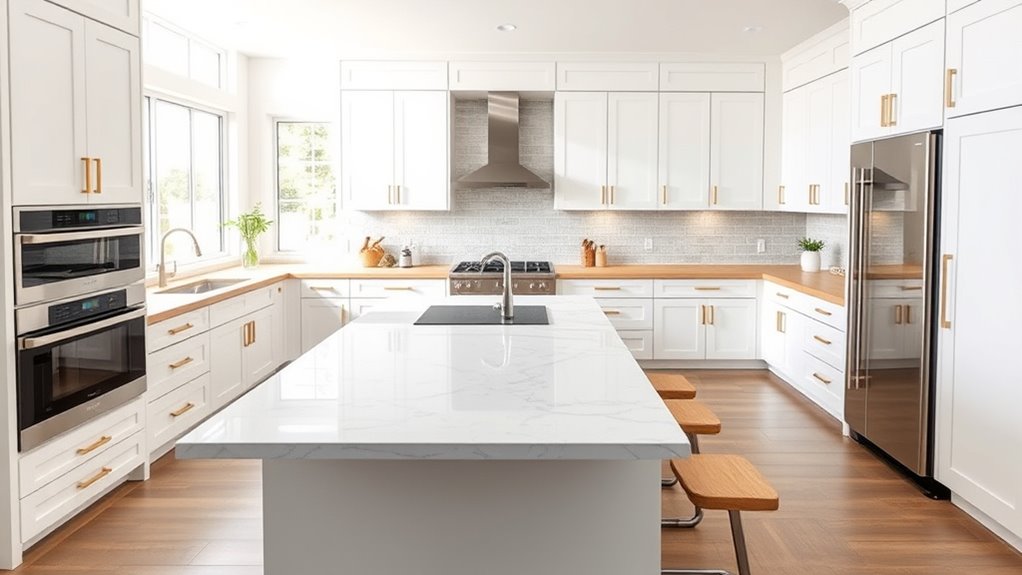To design an efficient kitchen layout, start by positioning your appliances near your prep area, creating smooth workflows with the classic work triangle: sink, stove, and refrigerator. Optimize storage with pull-out shelves, dividers, and vertical options to keep everything accessible. Use task lighting under cabinets and stylish pendant lights to brighten key zones. Balancing these elements boosts functionality and makes your kitchen both practical and inviting—exploring these tips further can help you craft the perfect space.
Key Takeaways
- Position appliances strategically near prep and cooking areas to streamline workflow and reduce movement.
- Optimize storage with cabinets, drawers, and vertical solutions for easy access and organization.
- Create work zones based on the kitchen triangle: sink, stove, and refrigerator for efficient task flow.
- Incorporate layered lighting—ambient, task, and accent—for visibility, safety, and ambiance.
- Balance layout elements considering routines and aesthetics to ensure a functional, organized, and appealing space.

Are you wondering how to create a kitchen layout that maximizes both functionality and style? The key lies in smart appliance placement and effective storage optimization. When designing your kitchen, think about where each appliance should go to make your workflow smooth and efficient. For example, placing your refrigerator near the prep area ensures easy access to ingredients without disrupting your cooking flow. Position your stove and oven close to the sink and prep zones to minimize movement and streamline meal prep. Proper appliance placement not only saves time but also keeps your kitchen organized and clutter-free.
Smart appliance placement enhances workflow and keeps your kitchen organized and clutter-free.
Storage optimization plays a vital role in creating a functional kitchen. You want to guarantee that everything has a designated spot, easily accessible when you need it. Use cabinets and drawers wisely by incorporating pull-out shelves, dividers, and lazy Susans to maximize space. Tall cabinets can store less frequently used items, while lower cabinets are perfect for everyday essentials. Installing hooks or rails inside cabinet doors can hold utensils, pot lids, or small tools, freeing up counter space. Think vertically as well—adding open shelving or hanging racks can keep frequently used items within reach and add a stylish touch.
When planning your layout, consider creating work zones. The classic work triangle connects the sink, stove, and refrigerator, minimizing steps during cooking and cleanup. Position these elements strategically to guarantee an efficient flow from one task to the next. For example, place the trash bin near the prep area for quick disposal of waste, and keep cutting boards and knives close to the prep zone. This setup reduces unnecessary movement, making your kitchen more ergonomic and enjoyable to cook in.
Lighting is also an important aspect of a well-designed kitchen. Combine ambient, task, and accent lighting to illuminate work areas and highlight design features. Proper lighting enhances safety and makes it easier to find what you need quickly. Under-cabinet lighting can brighten countertops, while pendant lights over islands add style and functionality. Additionally, understanding contrast ratio helps in selecting lighting setups that improve visibility and reduce eye strain, creating a comfortable cooking environment.
Ultimately, designing an efficient kitchen layout involves balancing appliance placement, storage optimization, workflow, and aesthetics. Take the time to plan where everything should go, keeping your daily routines and preferences in mind. With thoughtful planning, you’ll create a kitchen that’s not only beautiful but also a pleasure to cook and entertain in every day.
Frequently Asked Questions
How Can I Maximize Storage in a Small Kitchen?
You can maximize storage in your small kitchen by implementing smart storage solutions and focusing on vertical organization. Use wall-mounted shelves, hanging racks, and magnetic strips to free up counter space. Opt for stackable containers and pull-out drawers inside cabinets to utilize every inch efficiently. Incorporate hooks and hooks under cabinets for utensils and pots. These strategies help you make the most of limited space while keeping everything easily accessible.
What Are the Best Lighting Options for Different Kitchen Zones?
You should use a combination of task lighting and ambient lighting to brighten different kitchen zones. Install bright, focused task lights under cabinets for prep areas and above the stove for cooking. Use softer ambient lighting, like ceiling fixtures or recessed lights, to evenly illuminate the entire space. This layered approach guarantees you see clearly while creating a warm, inviting atmosphere, making your kitchen both functional and cozy.
How Can I Incorporate Eco-Friendly Materials Into My Design?
You can incorporate eco-friendly materials by choosing sustainable countertops like bamboo or recycled glass, which reduce environmental impact. Opt for recycled cabinetry made from reclaimed wood or eco-friendly composites to add character and sustainability. Using these materials not only benefits the planet but also creates a unique, stylish kitchen. Be sure to source from reputable suppliers to guarantee your eco-friendly choices are genuinely sustainable and high-quality, enhancing your overall design.
What Are Common Mistakes to Avoid in Kitchen Layout Planning?
You might think perfect layouts are easy, but avoiding common mistakes is key. Don’t overlook counter space; too little hampers meal prep. Also, plan for smooth traffic flow—cluttered pathways cause frustration. Avoid placing appliances or cabinets in awkward spots, which can block movement. Keep these in mind, and you’ll create a kitchen that’s both functional and comfortable, making cooking enjoyable instead of stressful.
How Do I Choose Appliances That Fit My Space and Needs?
To choose appliances that fit your space and needs, start by measuring appliance dimensions carefully, ensuring they match your available space. Consider energy efficiency ratings to save on long-term costs and reduce environmental impact. Think about how you’ll use each appliance—prioritize those that meet your cooking and storage needs. Opt for compact, multi-functional appliances when space is limited, and always double-check measurements before purchasing to avoid surprises.
Conclusion
Remember, designing your kitchen is like crafting a well-choreographed dance. When each element flows seamlessly, cooking becomes a graceful performance rather than a chaotic scramble. Keep the work triangle in mind, choose thoughtful placement, and don’t be afraid to personalize your space. With a little planning, you’ll create a kitchen that’s not just functional but a harmonious hub where every step feels natural—your culinary masterpiece in motion.








